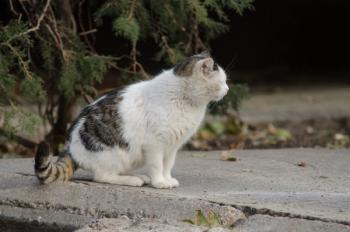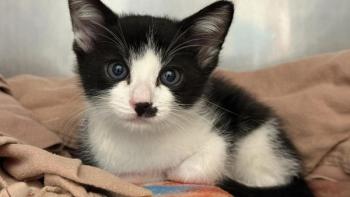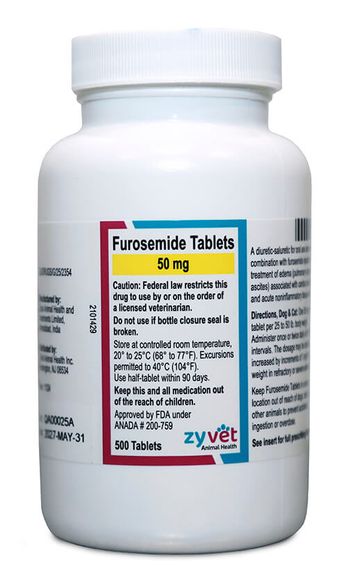
Dental Corner: How to detect and treat feline odontoclastic resorptive lesions
Tooth resorption is the most common dental problem in cats, with studies worldwide showing a prevalence rate (in cats presented for dental problems) of up to 75%.
Tooth resorption is the most common dental problem in cats, with studies worldwide showing a prevalence rate (in cats presented for dental problems) of up to 75%. Many species of animals as well as people experience various types of tooth resorption, but no other species experiences the prevalence of this condition that cats do. Resorptions of permanent teeth in cats have commonly been referred to as feline odontoclastic resorptive lesions (FORLs). They have also been called neck lesions, cervical line erosions, and feline caries.
Our understanding of FORLs has been enlightened by the use of dental radiography and by histologic studies.1,2 It appears that the lesions originate in the cementum, invade into dentin, and, from there, can progress apically (down the root), coronally (toward the crown), or both ways (Figure 1). Enamel often flakes off if its underlying dentin is involved. Enamel may also be resorbed (but from the inside out) once the lesion has progressed coronally into the tooth crown. The bottom line is that by the time we can clinically detect even small lesions by visual inspection or by probing or exploring, we are encountering an end-stage lesion.3 The cause of FORLs is unknown but is under investigation. All tooth-saving treatments have been shown to have poor results.
Figure 1. A schematic superimposed on a dental radiograph of a mandibular canine tooth illustrating the progression of an FORL. The lesion originates in the cementum (1), invades into dentin (2), and then progresses apically (3), coronally (4), or both ways. By the time we can clinically detect small lesions by visual inspection or by probing, we are encountering an advanced lesion. Figure 2. Note the localized, cherry-red, hyperplastic area of gingivitis on the mandibular third premolar. This is a classic clinical presentation of an FORL. This tooth should be probed with the patient under general anesthesia, and dental radiographs should be obtained.
CLINICAL APPEARANCE AND DIAGNOSIS
On oral examination, FORLs are often associated with a localized, cherry-red, sometimes hyperplastic area of gingivitis (Figure 2). The teeth most commonly affected are the mandibular third premolars; however, all 30 of a cat's teeth are at risk. An FORL can be demonstrated on oral examination by gently brushing the suspected lesion with a thin wisp from a broken wooden cotton-tipped swab or a coarse paper point tip. Gently stimulating these lesions often invokes a strong jaw-chattering response. FORLs are best diagnosed on oral examination of an anesthetized patient by probing with a dental explorer. Record any tooth crown or root defects in a dental chart. Other clinical signs that may be associated with FORLs include a bony bulge over the root of an affected tooth that may occur because of an osteoproliferative response to the root resorption (Figures 3A & 3B). The maxillary canine teeth are most commonly affected with this bone proliferation.
A diagnosis of an FORL requires radiographic evaluation. It is impossible to identify early lesions and make proper treatment decisions without dental radiographs. Every cat presented for dental treatment should undergo a full-mouth series of dental radiographs to screen for FORLs. However, it is possible to miss some lesions if you are relying on radiography alone. So the best diagnostic plan is to combine the findings of a thorough oral examination in an anesthetized patient with the results of a full-mouth dental radiographic examination.
Figures 3A & 3B. Note the bulge over the maxillary canine tooth root (3A). The dental radiograph (3B) shows evidence of an FORL with almost complete resorption of the root.
The earliest lesions, confined to the root cementum, are not painful. If the resorption spreads apically, there can be marked destruction of root structure without pain. However, if the lesion progresses coronally and exposes the dentin to the oral cavity, pain is definitely present. Secondary bacterial contamination and inflammation can affect the surrounding periodontal tissues as well. In other words, lesions you can probe or visualize are painful. Lesions you cannot probe but can see on radiographs are probably not painful.
Clinical signs associated with FORLs include anorexia, drooling, refusal to eat the hard portions of the diet, and malaise. The most common clinical presentation in cats with resorptive lesions may be no (overt) sign of pain. If a cat has an FORL in one tooth, it is safe to assume that the cat is at a high risk for other teeth to eventually become affected.
TREATING FORLS
Dividing a disease process into categories is helpful when it can guide treatment decisions. FORLs can be divided into three categories for this purpose: 1) normal-appearing teeth with radiographic evidence of an FORL, 2) teeth with clinical lesions and minimal radiographic root pathology, and (3) teeth with clinical lesions and radiographic evidence of root resorption and ankylosis (fusion between the root and alveolar bone).
Normal teeth with radiographic evidence of FORLs
Teeth that have been identified by radiography with evidence of FORLs but with no abnormal findings on oral examination (and, therefore, not painful) do not need to be immediately extracted. However, these teeth will probably progress to clinical disease at some time in the future. Conservative management (monitoring) is an option, but is incumbent upon a six-month recheck including anesthetizing and re-radiographing. And with monitoring, the prognosis is guarded. Alternatively, the affected teeth can be preemptively extracted.
Clinical lesions and minimal radiographic root pathology
If a tooth is clinically affected with an FORL but the radiographs show minimal evidence of root resorption (Figures 4A & 4B), extract the tooth. Extraction of feline teeth is accomplished by using proper surgical technique and high-speed dental equipment. Creating mucoperiosteal flaps and removing buccal cortical bone facilitate this procedure. Section multirooted teeth into their individual crown-root components, elevate the roots individually, and extract them routinely. If root fracture occurs, surgical root tip retrieval will be required.4,5
Figures 4A & 4B. The mandibular left molar (#309) has gross evidence of an FORL and a probable defect (4A). The dental radiograph (4B) shows a resorptive (external) lesion of the mesial root centered at the cementoenamel junction but minimal root resorption. Additionally, horizontal and vertical bone loss are evident. Both roots should be surgically extracted intact.
Clinical lesions and radiographic evidence of root resorption and ankylosis
A crown amputation procedure has been described to extract certain teeth exhibiting FORLs.6 In this procedure, you remove the crown of the tooth affected with an FORL while intentionally leaving the resorbing roots behind. Before performing this procedure, make sure there is no evidence of concurrent periodontal disease. Cats with associated periodontitis or stomatitis are not candidates for crown amputation. Dental radiography is essential for accurate diagnosis and treatment planning (Figures 5A-5C).
Figures 5A & 5B. The maxillary right third premolar (#107) shows evidence of an FORL on oral examination (5A). The dental radiograph (5B) shows #107 (white arrow) with extensive root resorption. This tooth is a good candidate for crown amputation. 5C. The tooth in Figures 5A & 5B before crown amputation. A mucogingival flap has been raised exposing the buccal cortical bone (1) overlying the resorbing roots. The crown (2) will be amputated along the black dotted line, intentionally leaving whatâÂÂs left of the roots behind. The flap is then reapposed with fine, absorbable suture.
In multirooted teeth, if only one root is affected with resorption, the root exhibiting the resorption should be crown-amputated, and the healthy root should be elevated and routinely extracted.
POSTOPERATIVE CARE
If you perform dental extraction or crown amputation, manage the patient's pain with a combination of preoperative and postoperative analgesia, intraoral regional nerve blocks, and analgesics for a few days after the procedure. A common protocol would include premedication with hydromorphone, appropriate intraoral regional nerve blocks with bupivacaine hydrochloride, postoperative hydromorphone, and a fentanyl patch. Of course, many other options are available, and the individual pain management plan should be based on the expected degree of pain and the patient's general health status.
Postoperative antibiotics are often given prophylactically for five to seven days. Antibiotics effective against gram-negative anaerobic bacteria are good choices. Other postoperative oral hygiene measures such as oral rinsing with chlorhexidine can be used, but they are often poorly tolerated by cats.
Reevaluate patients two or three weeks after the procedure to verify that healing has occurred. At that time, a dental home care program can be reinstituted. This may include a combination of tooth brushing, dental diets, appropriate chew treats, and a scheduled six-month recheck. Keep in mind that although a home care program is an important tool in preventing periodontal disease and other oral problems, nothing can be done at home to prevent FORLs. This fact has assuaged many clients' guilt.
REFERENCES
1. Gorrel C, Larsson A. Feline odontoclastic resorptive lesions: Unveiling the early lesion. J Small Anim Pract 2002;43:482-488.
2. Harvey CE, Orsini P, McLahan C, et al. Mapping of the radiographic central point of feline dental resorptive lesions. J Vet Dent 2004;21:15-21.
3. Gorrell C. A practical approach to managing feline odontoclastic resorptive lesions, in Proceedings. 18th Annu Vet Dent Forum 2004.
4. Bellows J. Oral surgical equipment, materials, and techniques. In: Small animal dental equipment, materials and techniques—A primer. Ames, Iowa: Blackwell Publishing, 2004;297-328.
5. Holmstrom SE, Frost P, Eisner ER. Exodontics. In: Veterinary dental techniques for the small animal practitioner. 2nd ed. Philadelphia, Pa: WB Saunders Co, 1998;216-244.
6. DuPont G. Crown amputation and intentional root retention for advanced feline resorptive lesions—A clinical study. J Vet Dent 1995;12:9-13.
"Dental Corner" was contributed by Daniel T. Carmichael, DVM, DAVDC, The Center For Specialized Veterinary Care, 609-5 Cantiague Rock Road, Westbury, NY 11590.
Newsletter
From exam room tips to practice management insights, get trusted veterinary news delivered straight to your inbox—subscribe to dvm360.






